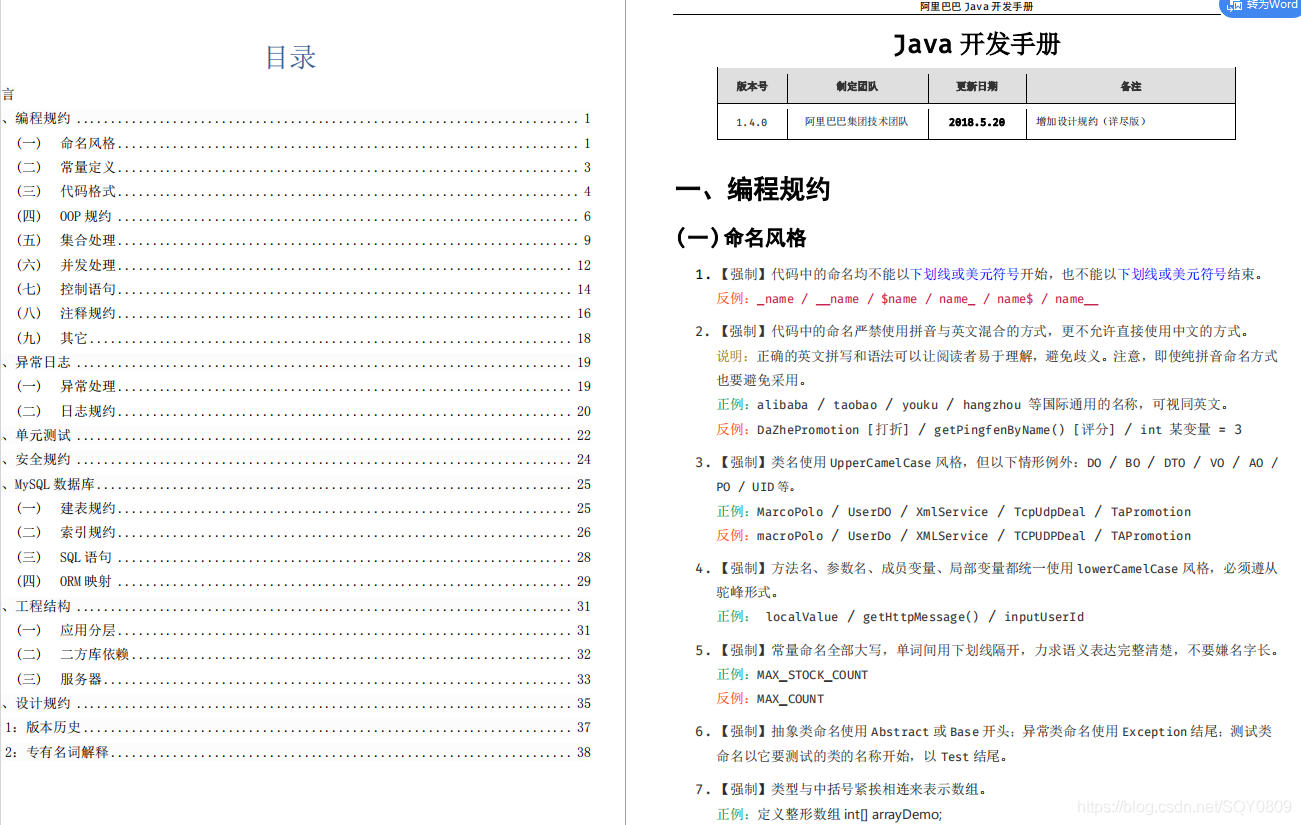十个写代码的小技巧,保你在面试过程中脱颖而出
工作了几个月,感觉自己代码很不规范,有很多冗余,比较乱,请问怎么针对性的改善代码规范?
下面分享一篇大佬的规范代码实操。
代码能够写成这样 666 啊,大佬收徒吗?

一、MyBatis 不要为了多个查询条件而写 1 = 1
当遇到多个查询条件,使用 where 1=1 可以很方便的解决我们的问题,但是这样很可能会造成非常大的性能损失,因为添加了 “where 1=1 ”的过滤条件之后,数据库系统就无法使用索引等查询优化策略,数据库系统将会被迫对每行数据进行扫描(即全表扫描) 以比较此行是否满足过滤条件,当表中的数据量较大时查询速度会非常慢;此外,还会存在 SQL 注入的风险。
反例:
<select id="queryBookInfo" parameterType="com.tjt.platform.entity.BookInfo" resultType="java.lang.Integer">select count(*) from t_rule_BookInfo t where 1=1<if test="title !=null and title !='' ">AND title = #{title}</if><if test="author !=null and author !='' ">AND author = #{author}</if></select>
正例:
<select id="queryBookInfo" parameterType="com.tjt.platform.entity.BookInfo" resultType="java.lang.Integer">select count(*) from t_rule_BookInfo t<where><if test="title !=null and title !='' ">title = #{title}</if><if test="author !=null and author !='' ">AND author = #{author}</if></where></select>
UPDATE 操作也一样,可以用标记代替 1=1。
二、迭代 entrySet() 获取 Map 的 key 和 value
当循环中只需要获取 Map 的主键 key 时,迭代 keySet() 是正确的;但是,当需要主键 key 和取值 value 时,迭代 entrySet() 才是更高效的做法,其比先迭代 keySet() 后再去通过 get 取值性能更佳。
反例:
//Map 获取value 反例:HashMap<String, String> map = new HashMap<>();for (String key : map.keySet()){String value = map.get(key);}
正例:
//Map 获取key & value 正例:HashMap<String, String> map = new HashMap<>();for (Map.Entry<String,String> entry : map.entrySet()){String key = entry.getKey();String value = entry.getValue();}
三、使用 Collection.isEmpty() 检测空
使用 Collection.size() 来检测是否为空在逻辑上没有问题,但是使用 Collection.isEmpty() 使得代码更易读,并且可以获得更好的性能;除此之外,任何 Collection.isEmpty() 实现的时间复杂度都是 O(1) ,不需要多次循环遍历,但是某些通过 Collection.size() 方法实现的时间复杂度可能是 O(n)
反例:
LinkedList<Object> collection = new LinkedList<>();if (collection.size() == 0){System.out.println("collection is empty.");}
正例:
LinkedList<Object> collection = new LinkedList<>();if (collection.isEmpty()){System.out.println("collection is empty.");}//检测是否为null 可以使用CollectionUtils.isEmpty()if (CollectionUtils.isEmpty(collection)){System.out.println("collection is null.");}
四、初始化集合时尽量指定其大小
尽量在初始化时指定集合的大小,能有效减少集合的扩容次数,因为集合每次扩容的时间复杂度很可能时 O(n),耗费时间和性能。
反例:
//初始化list,往list 中添加元素反例:int[] arr = new int[]{1,2,3,4};List<Integer> list = new ArrayList<>();for (int i : arr){list.add(i);}
正例:
//初始化list,往list 中添加元素正例:int[] arr = new int[]{1,2,3,4};//指定集合list 的容量大小List<Integer> list = new ArrayList<>(arr.length);for (int i : arr){list.add(i);}
五、使用 StringBuilder 拼接字符串
一般的字符串拼接在编译期 Java 会对其进行优化,但是在循环中字符串的拼接 Java 编译期无法执行优化,所以需要使用 StringBuilder 进行替换。
反例:
//在循环中拼接字符串反例String str = "";for (int i = 0; i < 10; i++){//在循环中字符串拼接Java 不会对其进行优化str += i;}
正例:
//在循环中拼接字符串正例String str1 = "Love";String str2 = "Courage";String strConcat = str1 + str2; //Java 编译器会对该普通模式的字符串拼接进行优化StringBuilder sb = new StringBuilder();for (int i = 0; i < 10; i++){//在循环中,Java 编译器无法进行优化,所以要手动使用StringBuildersb.append(i);}
六、若需频繁调用 Collection.contains 方法则使用 Set
在 Java 集合类库中,List 的 contains 方法普遍时间复杂度为 O(n),若代码中需要频繁调用 contains 方法查找数据则先将集合 list 转换成 HashSet 实现,将 O(n) 的时间复杂度将为 O(1)。
反例:
//频繁调用Collection.contains() 反例List<Object> list = new ArrayList<>();for (int i = 0; i <= Integer.MAX_VALUE; i++){//时间复杂度为O(n)if (list.contains(i))System.out.println("list contains "+ i);}
正例:
//频繁调用Collection.contains() 正例List<Object> list = new ArrayList<>();Set<Object> set = new HashSet<>();for (int i = 0; i <= Integer.MAX_VALUE; i++){//时间复杂度为O(1)if (set.contains(i)){System.out.println("list contains "+ i);}}
七、使用静态代码块实现赋值静态成员变量
对于集合类型的静态成员变量,应该使用静态代码块赋值,而不是使用集合实现来赋值。
反例:
//赋值静态成员变量反例private static Map<String, Integer> map = new HashMap<String, Integer>(){{map.put("Leo",1);map.put("Family-loving",2);map.put("Cold on the out side passionate on the inside",3);}};private static List<String> list = new ArrayList<>(){{list.add("Sagittarius");list.add("Charming");list.add("Perfectionist");}};
正例:
//赋值静态成员变量正例private static Map<String, Integer> map = new HashMap<String, Integer>();static {map.put("Leo",1);map.put("Family-loving",2);map.put("Cold on the out side passionate on the inside",3);}private static List<String> list = new ArrayList<>();static {list.add("Sagittarius");list.add("Charming");list.add("Perfectionist");}
八、删除未使用的局部变量、方法参数、私有方法、字段和多余的括号。
九、工具类中屏蔽构造函数
工具类是一堆静态字段和函数的集合,其不应该被实例化;但是,Java 为每个没有明确定义构造函数的类添加了一个隐式公有构造函数,为了避免不必要的实例化,应该显式定义私有构造函数来屏蔽这个隐式公有构造函数。
反例:
public class PasswordUtils {//工具类构造函数反例private static final Logger LOG = LoggerFactory.getLogger(PasswordUtils.class);public static final String DEFAULT_CRYPT_ALGO = "PBEWithMD5AndDES";public static String encryptPassword(String aPassword) throws IOException {return new PasswordUtils(aPassword).encrypt();}
正例:
public class PasswordUtils {//工具类构造函数正例private static final Logger LOG = LoggerFactory.getLogger(PasswordUtils.class);//定义私有构造函数来屏蔽这个隐式公有构造函数private PasswordUtils(){}public static final String DEFAULT_CRYPT_ALGO = "PBEWithMD5AndDES";public static String encryptPassword(String aPassword) throws IOException {return new PasswordUtils(aPassword).encrypt();}
十、删除多余的异常捕获并跑出
用 catch 语句捕获异常后,若什么也不进行处理,就只是让异常重新抛出,这跟不捕获异常的效果一样,可以删除这块代码或添加别的处理。
反例:
//多余异常反例private static String fileReader(String fileName)throws IOException{try (BufferedReader reader = new BufferedReader(new FileReader(fileName))) {String line;StringBuilder builder = new StringBuilder();while ((line = reader.readLine()) != null) {builder.append(line);}return builder.toString();} catch (Exception e) {//仅仅是重复抛异常 未作任何处理throw e;}}
正例:
//多余异常正例private static String fileReader(String fileName)throws IOException{try (BufferedReader reader = new BufferedReader(new FileReader(fileName))) {String line;StringBuilder builder = new StringBuilder();while ((line = reader.readLine()) != null) {builder.append(line);}return builder.toString();//删除多余的抛异常,或增加其他处理:/*catch (Exception e) {return "fileReader exception";}*/}}
文章到这里就结束了
为了让大家能够更加规范的编写代码,小编这里为大家准备了一份阿里巴巴开发手册,需要的小伙伴们可以关注公众号【Java 斗帝】回复“666”免费获取以下资料;


喜欢小编的分享可以点赞关注哦,小编持续为你分享最新文章 和 福利领取哦
看完三件事❤️
如果你觉得这篇内容对你还蛮有帮助,我想邀请你帮我三个小忙:
点赞,转发,有你们的 『点赞和评论』,才是我创造的动力。
关注公众号 『 Java 斗帝 』,不定期分享原创知识。
同时可以期待后续文章 ing🚀












评论